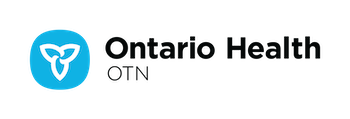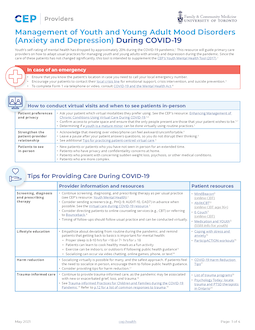The following condition-specific resources were developed in the context of the COVID-19 pandemic, when necessity required deviation from existing evidence-based guidelines as in-person visits were significantly limited. Certain frameworks and guidance within the resources are applicable only to the “crisis care” needs during the COVID-19 pandemic and should be reviewed with this consideration in mind. Established Clinical Practice Guidelines are the authoritative source for evidence-based care for each condition.
Management of Youth and Young Adult Mood Disorders (Anxiety and Depression) During COVID-19

Youth’s self-rating of mental health has dropped by approximately 20% during the COVID-19 pandemic.1 This resource will guide primary care providers on how to adapt usual practices for managing youth and young adults with anxiety and depression during the pandemic. Since the care of these patients has not changed significantly, this tool is intended to supplement the CEP’s Youth Mental Health Tool (2017).
In case of an emergency
- Ensure that you know the patient’s location in case you need to call your local emergency number.
- Encourage your patients to contact their local crisis line for emotional support, crisis intervention, and suicide prevention (211 Ontario, 2021).
- To complete Form 1 via telephone or video, consult COVID-19 and the Mental Health Act (CAMH, 2020).
How to conduct virtual visits and when to see patients in-person
Patient preferences
and privacy
- Ask your patient which virtual modalities they prefer using. See the CEP’s resource: Enhancing Management of Chronic Conditions Using Virtual Care During COVID-19 (CEP, 2021).
- Inquire if your patient would prefer having a family member or trusted individual present.
- Confirm access to private space and ensure that the only people present are those that your patient wishes to be (CEP, 2021; SickKids, 2020).
- Determining if a youth is a mature minor can be done virtually using routine practices (CEP, 2017).
Strengthen the patient-provider relationship
- Acknowledge that meeting over video/phone can feel awkward/uncomfortable (Expert opinion, 2021).
- Leave a pause after your patient answers questions, so you do not disrupt their thinking (Expert opinion, 2021).
- See additional Tips for practicing patient-centred virtual care (CEP, 2021).
Patients to see in-person
- New patients or patients who you have not seen in person for an extended time.
- Patients who have privacy and confidentiality concerns at home.
- Patients who present with concerning sudden weight loss, psychosis, or other medical conditions
- Patients who are more complex.
Click on the sections below to get started:
Tips for Providing Care During COVID-19
Screening, diagnosis and prescribing therapy
- Continue screening, diagnosing, and prescribing therapy as per usual practice (see CEP’s resource: Youth Mental Health).
- Consider sending screeners (e.g., PHQ-9, AUDIT-10, GAD7) in advance when possible. See the Virtual care during COVID-19 resource.
- Consider directing patients to online counseling services (e.g., CBT) or referring to Bounceback.
- Timing of follow-ups should follow usual practice and can be conducted virtually.
Patient resources
- MindBeacon (Anxiety Canada, 2021 ) (online CBT)
- AbilitiCBT (online CBT age 16+) (Morneau Shepell, 2020)
- E-Couch (online CBT) (ehubHealth, 2020)
- Medication and YOUth (SSRI info for youth) (CAMH, 2020)
- Mindshift CBT (Anxiety Canada, 2021) (online CBT)
- Depression Patient Guide (OHQ, 2016)
- Anxiety Patient Guide (OHQ, 2020)
Lifestyle education
- Empathize about deviating from routine during the pandemic, and remind patients that getting back to basics is important for mental health:
- Proper sleep is 8-10 hrs for <18 or 7+ hrs for ≥ 18
- Patients can learn to cook healthy meals as a fun activity
- Exercise can be indoors, or outdoors if following public health guidance (HealthLinkBC, 2020)
- Socializing can occur via video chatting, online games, phone, or text (CAMH, 2020)
Patient resources
- Coping with stress and anxiety (CAMH, 2020)
- Additional mental health resources (CAMH, 2020)
- ParticipACTION workouts (2021)
- Headspace (Headspace Inc, 2021) (Meditation app – fees may be included to unlock all features)*
- Calm (Calm, 2021) (Meditation app – fees may be included to unlock all features)*
Harm reduction
- Socializing virtually is possible for many, and the safest approach. If patients feel the need to socialize in person, encourage them to follow public health guidance.
- Consider providing tips for harm reduction (TPH, 2020).
Patient resources
Trauma-informed care
- Continue to provide trauma-informed care, as the pandemic may be associated with new or exacerbated grief, loss, and trauma.
- See Trauma-informed Practices for Children and Families during the COVID-19 Pandemic. Refer to p.12 for a list of common responses to trauma (PHO, 2020).
* Note: reference to brand names does not imply endorsement of any of these products
HEEADSSSS During COVID-19
The HEEADSSSS framework helps to inform the screening process and documentation of patient history.
H – Home
School closures and increased distress among caregivers have increased the risks of child abuse and domestic violence (University of Toronto, 2020).
- “Have your relationships at home (e.g., caregiving), or who you live with changed during the pandemic?”
- “Are you worried about getting COVID-19 at school/work/outside and bringing it home?”
E – Education / Employment
Youth and other vulnerable populations have been bearing the brunt of job losses, with youth unemployment at 22% (FAO, 2021).
- “Are you working, and has your employment changed during the pandemic?”
Remote learning may exacerbate the symptoms of ADHD and social anxiety for youth who have returned/are returning toin-person classes (J Adolesc Health, 2020).
- “Have your plans for school (e.g., university) changed during the pandemic?”
- “Have you been working/learning in person, or virtually? How has that been going?”
Provider resources
- Transition to adult care for youth with special health care needs (CPS, 2020)
- Transitioning into post- secondary education: A resource for front- line staff supporting students (Centre for Innovation, 2020)
Patient resources
- What financial support is there for young people during COVID-19? (New Youth, 2020)
- Government of Canada: Canada Student Loans – Covid-19 (Government of Canada, 2020)
- Please check if you are eligible through the Employee Assistance Program (EAP) to be referred to a mental health professional
E – Eating
The pandemic has negatively impacted individuals with eating disorders, and in some studies, almost half of respondents reported a change in eating habits (Nutrients, 2020).
- “Have your eating habits changed during the pandemic?”
- “Do you or your parents ever worry about running out of food before having enough money to buy more?”
- “Has your weight changed during the pandemic?”
- “Has your perception of your body and/or body image changed during the pandemic”
A – Activities
Less than 5% of youth met recommended physical activity guidelines during the first month of the pandemic in Canada (BC CDC, 2021). Many youths and young adults feel fatigued from virtual meetings/hangouts.
- “What have you been doing for fun during the pandemic?”
- “Have you found it difficult to socialize or exercise during the pandemic?“
D – Drugs / Drinking
Alcohol and cannabis use in youth has increased during the pandemic, with 21% of Canadians aged 18-34 reporting increased drinking (Drug Free Kids Canada, 2020).
- “Do you drink alcohol or use tobacco, electronic cigarettes, cannabis, or any other drugs? Is your use the same as it was before the pandemic?”
Provider resources
- Brief Screening Tools for Adolescent Substance Use (NIH, 2019)
- AUDIT-10 Interview Version (NIH, 2020)
Patient resources
S – Sexuality and Gender
During the pandemic, risky sexual behaviours (e.g., sexting) may increase among youth (SIECUS, 2020).
- “Have you had any physical or online sexual relationships during the pandemic?”
- “Have the types of sexual relationships you have changed significantly during the pandemic?”
S – Suicide / Self-harm
Kids Help Phone has seen an increase in volume to their phone line of 170% and an increase of 114% to their text line (Mental Health Commission of Canada, 2020). Marginalized groups (e.g., LGBTQ+ and indigenous youths) are particularly at risk (CAMH, 2020; Statistics Canada, 2020)
- “Do you feel more stressed or anxious than usual?”
- “Have you thought about hurting yourself or someone else?”
S – Safety (from injury and violence)
When considering perceptions of neighbourhood safety during the pandemic, younger people were more likely to feel an increase in crime and race-based violence (Statistics Canada, 2020).
- “Have you felt safe in your neighbourhood since the start of the pandemic?” (Starship, 2019)
- “Do you feel vulnerable or at risk of harm because of your culture, race, and/or sexual orientation?”
Provider resources
Patient resources
- Crisis Text Line (2021)
Text: HOME to 686868 - Resources on how to prevent injuries (Parachute, 2021)
S – Social Media
Reports of online sexual exploitation of children have increased by 88% during the pandemic (Cybertip, 2021).
- “Have you or a group that you identify with (e.g., culturally, racially, sexually) been picked on or bullied online more often/severely during the pandemic?”
Caring for patients during the pandemic is stressful, and feelings of extreme exhaustion and burnout are normal. For help during these times, see mental health and well-being supports and take care of yourself!
Virtual patient resources for Management of Youth and Young Adult Mood Disorders
Due to the COVID-19 pandemic, many resources to support patients are now available virtually. The following is a list of virtual resources that you can use in the management of your care.
General

Screening, diagnosis and prescribing therapy
- MindBeacon (Anxiety Canada, 2021 ) (online CBT)
- AbilitiCBT (online CBT age 16+) (Morneau Shepell, 2020)
- E-Couch (online CBT) (ehubHealth, 2020)
- Medication and YOUth (SSRI info for youth) (CAMH, 2020)
- Mindshift CBT (Anxiety Canada, 2021) (online CBT)
- Depression Patient Guide (OHQ, 2016)
- Anxiety Patient Guide (OHQ, 2020)
HEEADSSSS

Drugs / Drinking

Safety (from injury and violence)
- Crisis Text Line (2021)
Text: HOME to 686868 - Resources on how to prevent injuries (Parachute, 2021)
Acknowledgment and legal
This Resource was developed by the Centre for Effective Practice and Department of Family and Community Medicine, University of Toronto. Clinical leadership for the development of the Resource was provided by Dr. Anna Holland and by the Management of Youth and Young Adult Mood Disorder (Anxiety and Depression) During COVID-19 Working Group. The Managing Chronic Conditions during COVID-19 Advisory Committee provided feedback and input. This Resource was also subject to external review by health care providers and other relevant stakeholders. The development of this Resource was funded by the Government of Ontario as part of the Knowledge Translation in Primary Care.
Clinical Lead
• Anna Holland MD CCFP (AM)
Working Group
• Payal Agarwal MD, CCFP, BASC
• Mia Biondi PhD, NP-PHC
• Patricia Windrim MD, CCFP, MHS
• Rebekah Neckoway MD, CCFP
Advisory Committee
• Noah Ivers, MD, PhD, CCFP
• Tara Kiran, MD, MSc, CCFP, FCFP
• Daniel Pepe, MD, CCFP
• Sarah Newbery MD, CCFP, FCFP, FRRMS
• Nicole Nitti, MD, CCFP(EM), FCFP
• Anna Holland MD, CCFP (AM)
• Mia Biondi PhD, NP-PHC
• Jennifer Young, MD, FCFP-EM (Ontario College of Family Physicians)
• Kevin Samson MD (Association of Family Health Teams of Ontario)
• Danika Voisin (eHealth Centre of Excellence)
• Laurie Poole RN, MHSA (Ontario Health, OTN)
• Reza Talebi MD, MSc (OntarioMD)
• Maurine Parzen RN, PhD (Patient Representative)
Thank you to everyone who supported the development of this resource.
Conflict of interest
• Clinical Leads receive compensation for their role
• Clinical Working Group receive an honorarium for their participation
• Focus group and usability participants receive a small token of appreciation (e.g. gift certificate)
This Resource was developed for licensed health care professionals in Canada as a guide only and does not constitute medical or other professional advice. Primary care providers and other health care professionals are required to exercise their own clinical judgment in using this Resource.
Management of Youth and Young Adult Mood Disorder (Anxiety and Depression) During COVID-19 is a product of the Centre for Effective Practice and Department of Family and Community Medicine, University of Toronto. Permission to use, copy, and distribute this material for all non-commercial and research purposes is granted, provided the above disclaimer, this paragraph and the following paragraphs, and appropriate citations appear in all copies, modifications, and distributions. Use of Management of Youth and Young Adult Mood Disorder (Anxiety and Depression) During COVID-19 for commercial purposes or any modifications of the Resource are subject to charge and use must be negotiated with the Centre for Effective Practice (Email: info@cep.health).
Developed by

With support from







